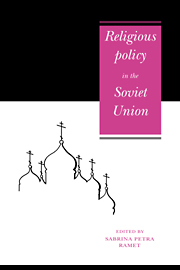Book contents
- Frontmatter
- Contents
- Notes on contributors
- Preface
- Part I Introduction
- Part II Policy apparatus
- 3 The Council for Religious Affairs
- 4 Some reflections about religious policy under Kharchev
- 5 The state, the church, and the oikumene: the Russian Orthodox Church and the World Council of Churches, 1948–1985
- Part III Education, socialisation, and values
- Part IV Cults and sects
- Part V The world of Christianity
- APPENDIX: Religious groups numbering 2,000 or more, in the USSR
- Index
3 - The Council for Religious Affairs
Published online by Cambridge University Press: 03 December 2009
- Frontmatter
- Contents
- Notes on contributors
- Preface
- Part I Introduction
- Part II Policy apparatus
- 3 The Council for Religious Affairs
- 4 Some reflections about religious policy under Kharchev
- 5 The state, the church, and the oikumene: the Russian Orthodox Church and the World Council of Churches, 1948–1985
- Part III Education, socialisation, and values
- Part IV Cults and sects
- Part V The world of Christianity
- APPENDIX: Religious groups numbering 2,000 or more, in the USSR
- Index
Summary
The beginnings of the present-day authority for the state control and supervision of religious communities reach back to the October Revolution, namely to the commission formed in 1917 by the National Commissariat of Justice, which, under the direction of the well-known lawyer M.A. Rejssner, formulated the edict of 23 January 1918 on the separation of church from state and school from church which is formally still valid today. After completion of that task in April 1918, this commission was continued in an interministerial special commission, also established by the commissary of justice, for the continuing development of cult-legislation. The commission was then integrated in May of 1918 into the Commissariat as the department for administration of the edict of separation. Led by the prominent Bolshevik P.A. Krasikov, its main task consisted in the practical accomplishment of the liquidation of the now secularised church property. Soon it was referred to as the ‘liquidation department’ or, alternatively, the ‘8th department’. In addition, the department had the characteristics of a consulting agency for the central governmental apparatus. In other words, it should provide binding answers to questions from the side of state institutions on the application of the cultlegislation, rule with final authority and precedent-setting influence in eventual disputes, and develop drafts for further cult laws. Furthermore, and this was most unusual for a department of the ministry of justice, it should also observe and co-operate in controlling the political activities of so-called ‘clerical parties’, in other words those powers in the religious communities which stood in opposition to the Soviet state. Thus the religious board of control's double function, valid until recently, emerged at a very early point in time.
- Type
- Chapter
- Information
- Religious Policy in the Soviet Union , pp. 55 - 83Publisher: Cambridge University PressPrint publication year: 1992

